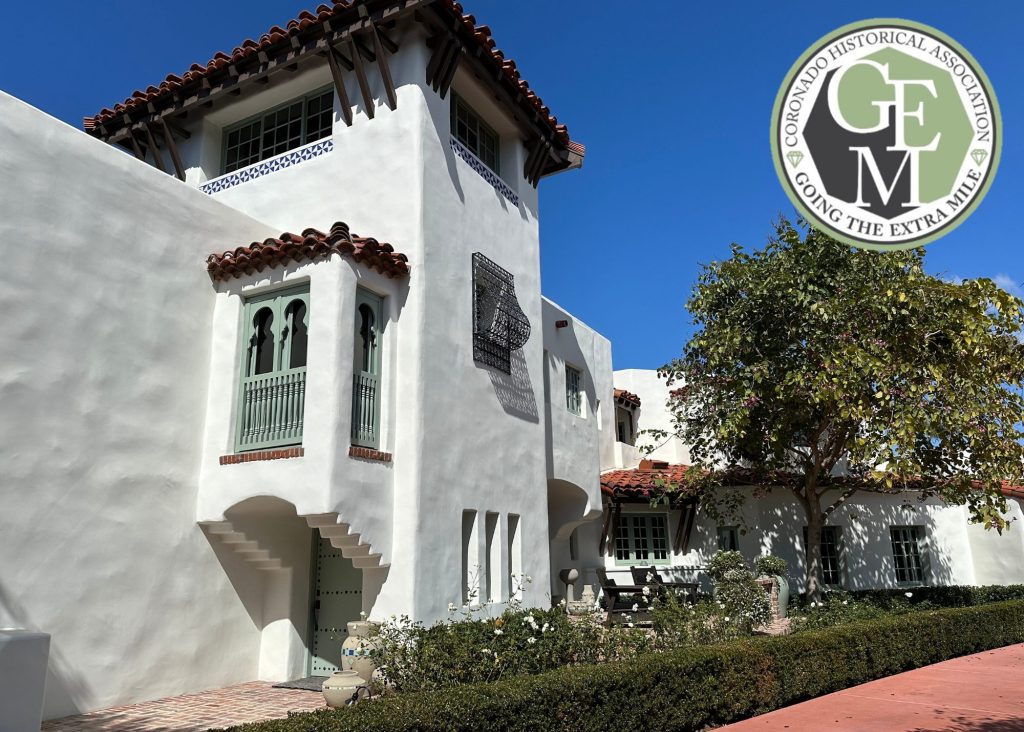Fresh from his first trip to Spain and Morocco, San Diego architect Richard Requa incorporated many Spanish and Moorish elements he recorded on travels into the home he designed at 1045 Loma Ave in 1926. The cost for the sprawling estate was an extravagant $29,600.
A September 1926 story in the Eagle & Journal states: “The site is being prepared on lots 8, 9 and 10, block 14 fronting on Loma and Flora Avenues and Star Park, for a magnificent new residence to be constructed for Mr. and Mrs. Samuel Mann of this city. The chosen location is a part of the large grounds formerly belonging to the Lacy home, and there is already a profusion of rare trees, plants and shrubbery, including a group of large cocos plumosa trees on the site, most of which need not be disturbed. The residence, which has been designed by Requa & Jackson of San Diego, features an unusual but very pleasing treatment of the flat roof, which heretofore has not always been successfully adapted to Southern California environment. There will be a large central tower-like section excellently designed to harmonize perfectly with the long facade of the building, which has remarkably generous proportions. With its latticed balconies, alcoves, balustrades, and wonderfully ornate windows, this newest addition to Coronado’s mansions will easily convey the suggestion of an oriental palace.”
It is interesting to note that the building permits and Requa’s architectural drawings both state the home was built for a Mrs. D.E. Mann.
Throughout the 1920s, Requa developed what he called the Southern California style, which was heavily influenced by the simple architecture found in Spain and Northern Africa, as well as the pueblos of the Southwest and colonial buildings of Mexico. Requa, who was named the master architect for the California Pacific International Exposition in 1935-36 in Balboa Park, designed some of his most imaginative homes in Coronado, unconfined by budgetary restrictions.
With the guidance of the original architectural drawings, the current homeowners returned the building to its original glory, reversing decades of nonconforming alterations that took away from Requa’s design. They also purchased the neighboring lot, which was part of the original estate, removing the 1960s house to provide their home with the spacious grounds Requa and landscape designer Milton Sessions envisioned.
During the renovation, which was done by Nance Construction, the owners found some original sconces and light fixtures in the home’s crawl space and had those replicated throughout the home. They also discovered the original brick work on the living room fireplace after removing the marble that had been on top. The original front door was restored, and original doors and hardware were used whenever possible on the interior. Hand-troweled plaster on the walls re-created the look the home would have had in the 1920s.
The original corbels were uncovered on the front dining patio. To complete the look on the patio, tilework, pots, and a brick wall that Requa had in his designs were re-created. The homeowners were also able to find the original sage color on an exterior tower window frame, hidden below many coats of paint. That color and a dark brown were used for the exterior windows and accents.
Every detail of the restoration was done to honor Requa’s plans for the home, from the air vents to the light fixtures to the antique California furniture and pottery.
The homeowner said she was drawn to house because of its location and Spanish architecture without knowing much about its past.
“It was so fun doing the research on Richard Requa and his life and accomplishments, which drove us to try to replicate this home back to his original intent,” she said. “Studying Requa and his knowledge of architecture was definitely one of the highlights of the restoration — being able to hopefully ‘make him proud’ if he were here today.”
“Even though the renovation took four years to complete, I enjoyed every minute of it and am so honored that we are the stewards, at this time, of the home,” she said. “Our hope is that the work and love we put into the home, will allow it to last and be appreciated for another 100-plus years!”
_______________________
In honor of the 10th Anniversary of the GEM Awards, the Coronado Historical Association is pleased to announce that there is a prodigious group of ten finalists for this year’s award, the largest group of finalists in the awards history. This year’s finalists include historic properties at: 1026 Flora Avenue, 1045 Loma Avenue, 1135 Loma Ave, 1315/1319 5th Street, 275 J Avenue, 350 D Avenue, 519 Ocean Boulevard, 520 J Avenue, 870 H Avenue, and 874 A Avenue.
Established in 2013, the GEM Awards have become a tradition in recognizing homeowners who retain and maintain Coronado’s unique character. By choosing renovation over replacement, homeowners are celebrated for their unwavering commitment to preserving the island’s architectural history and fostering connections to the past. These awards serve as a public acknowledgment of their dedication to the past. This year’s Awards Ceremony, where the winners will be announced, will be held on Wednesday, April 3rd at 5:30 pm at the City’s Nautilus Room. Tickets can be purchased on CHA’s website or by calling 619-435-7242.
To delve into the remarkable preservation efforts undertaken by the nominees, CHA is spotlighting the history of each home.





